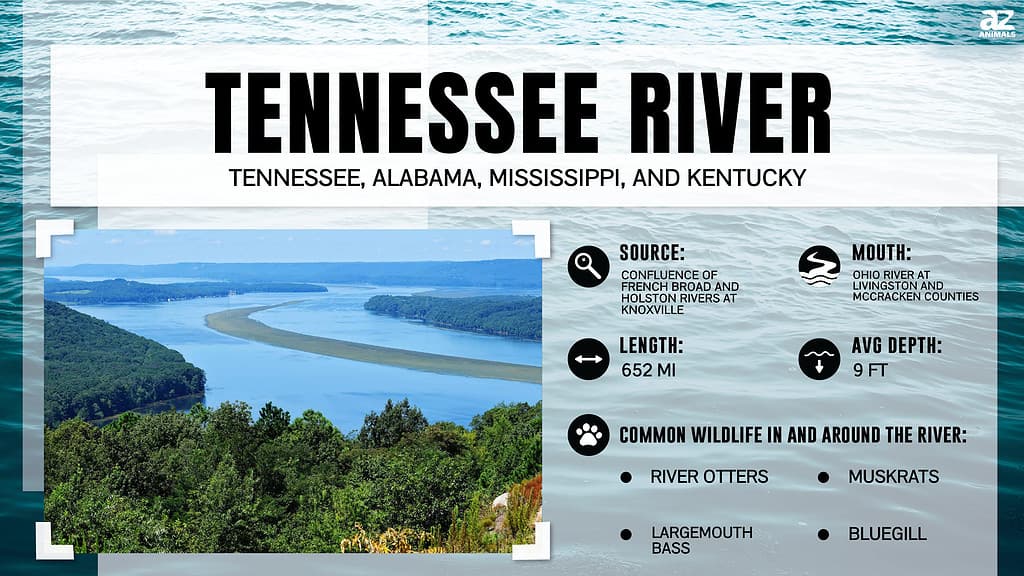
Tennessee is home to the Appalachian Mountains, Nashville, Chattanooga, and even the Tennessee River. It is also a habitat for more than 30 species of snake, several of which have enough venom to send a human to the hospital. The snakes of the Tennessee River are overwhelmingly aquatic or semi-aquatic, but only one of them has a bite that packs a punch.
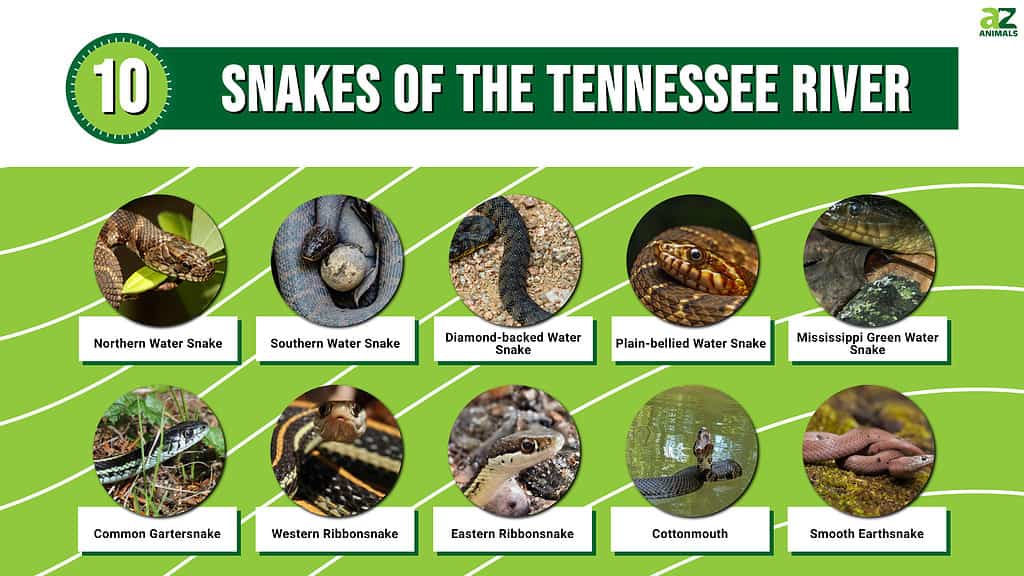
Here, we’ll take a look at ten species of snake that live in and around the Tennessee River. We’ll discover what they look like, what they eat, and where you might find them.
Read on to learn more about the snakes of the Tennessee River!
1. Northern Water Snake
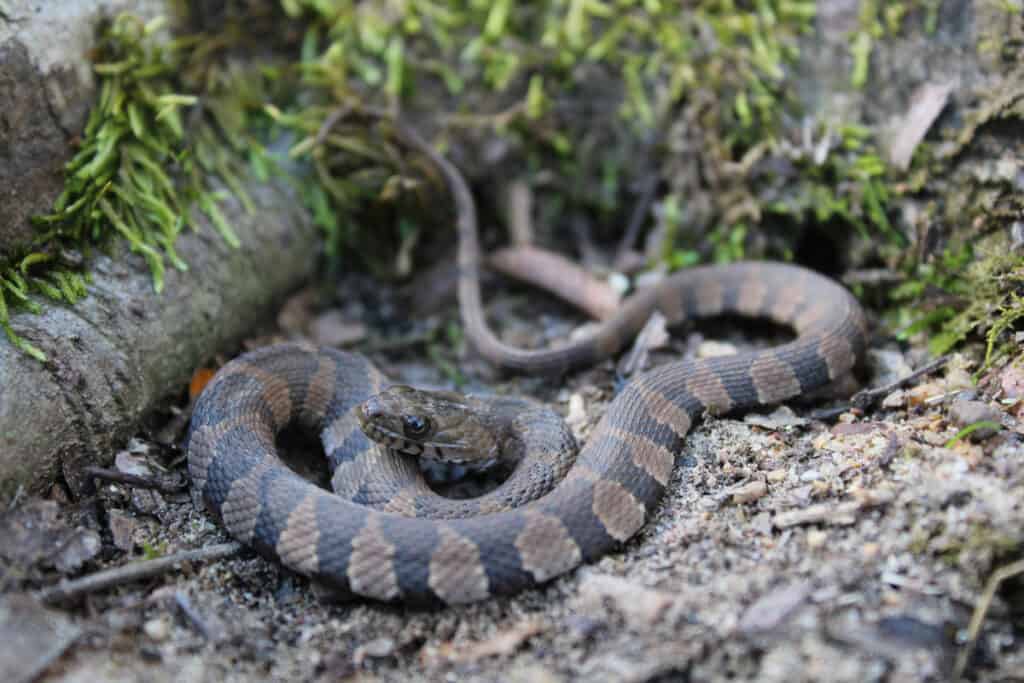
Two subspecies of northern water snakes live in Tennessee: the common watersnake and the midland watersnake.
©Tucker Heptinstall/Shutterstock.com
Northern water snakes of the Tennessee River grow up to 42 inches long, though they may be as short as 24 inches. They’re gray to brown, with red or brown crossbands on their sides and dark blotches on their backs. Their heads are approximately the same width as their bodies, and they have round eyes with short snouts. These snakes eat small fish and amphibians.
2. Southern Water Snake

Only one subspecies of the southern water snake exists the broad-banded water snake.
©Deborah Ferrin/Shutterstock.com
Southern water snakes of the Tennessee River grow between 22 and 36 inches long. They have medium-heavy bodies marked by alternating dark brown and yellow scales. Their undersides are bright yellow with dark brown squares. They bear a superficial resemblance to cottonmouths, though their heads are much narrower, and they lack the cottony white mouths. These snakes prey mainly on toads, frogs, fish, crayfish, and salamanders.
3. Diamond-backed Water Snake
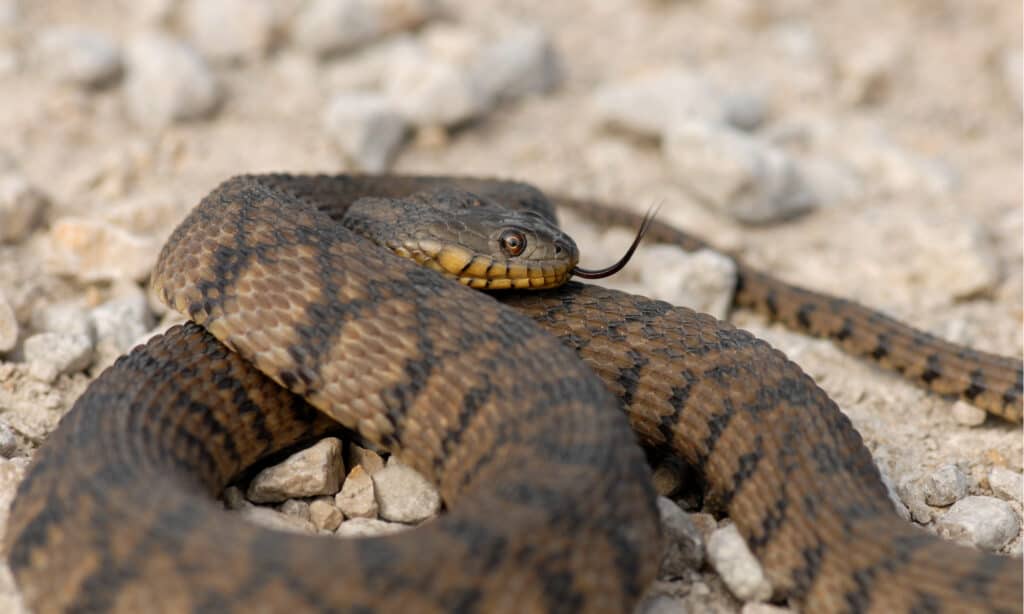
Diamondback water snakes are nonvenomous.
©Rusty Dodson/Shutterstock.com
Diamond-backed water snakes of the Tennessee River grow up to 48 inches long but may be as short as 30 inches as adults. They have gray to brown bodies, yellow bellies, and red, round eyes. Their heads are a little thicker than other water snakes, with short noses and strong jaws. Juveniles have very bold patterns with bright orange undersides. These snakes bear a superficial resemblance to cottonmouths but lack distinct diamond-like patterning. They eat fish and amphibians.
4. Plain-bellied Water Snake
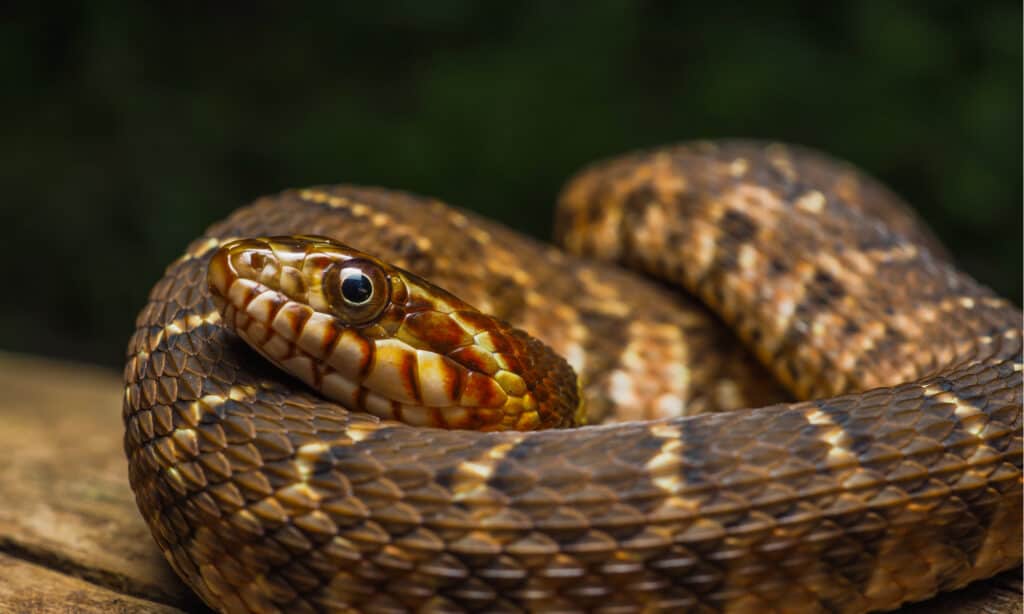
Plain-bellied water snakes are often mistaken for venomous cottonmouths.
©Tyler Albertson/Shutterstock.com
The plain-bellied water snakes of the Tennessee River grow up to 48 inches long, or four feet. Adults are nearly black, with gray or green tinted scales and very little patterning. They have unpatterned, bright yellow undersides. Juveniles look almost nothing like adults, with strong black and pale orange-tinted patterning on the backs and sides. These snakes eat crayfish, fish, frogs, tadpoles, and salamanders.
5. Mississippi Green Water Snake

These snakes live only in western Tennessee, they’re found specifically in cypress swamps.
©Ryan M. Bolton/Shutterstock.com
The Mississippi green water snakes of the Tennessee River grow to between 30-45 inches long as adults. They’re much greener than other water snakes, with boldly patterned bellies. Their backsides are olive to dark green, with some darker markings. Their undersides are checkered yellow and green. These snakes have narrow heads with round, green eyes. They eat fish, crayfish, and amphibians. Mississippi green water snakes are rare and in danger of extinction from habitat loss.
6. Common Gartersnake
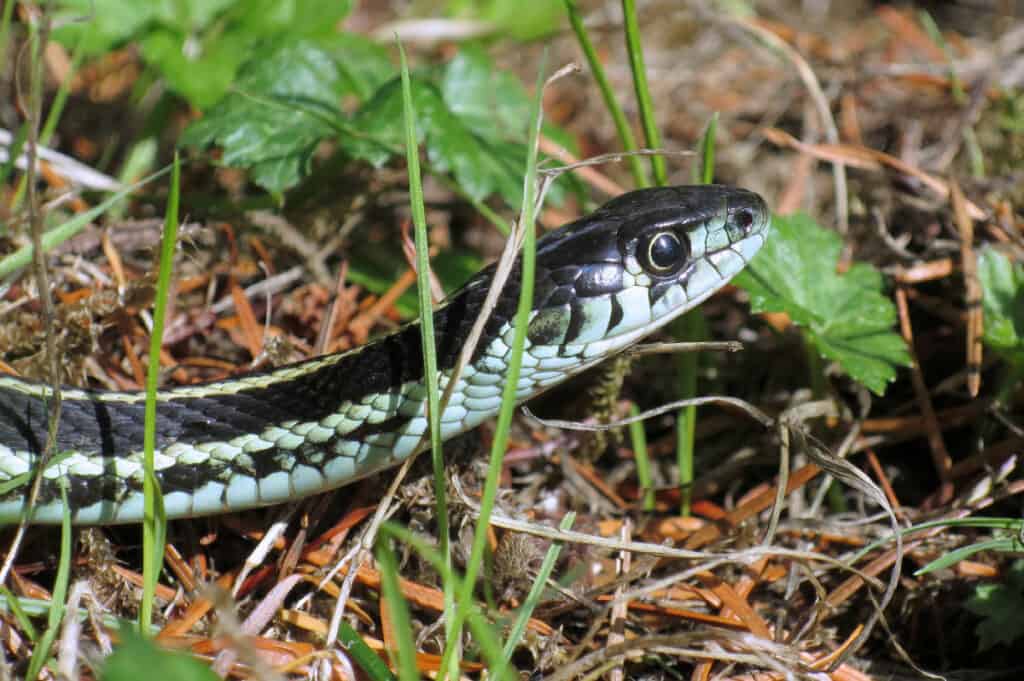
Only one subspecies of common garter snake lives in Tennessee, and that’s the eastern garter snake.
©iStock.com/randimal
The common garter snakes of the Tennessee River are small, growing to a maximum length of 26 inches long. They may be as small as 18 inches as adults. These snakes have alternating bands of dark brown and pale yellow running from head to tail. Some of their stripes are solid, while others are checkered. These snakes eat amphibians, fish, and earthworms.
7. Western Ribbonsnake
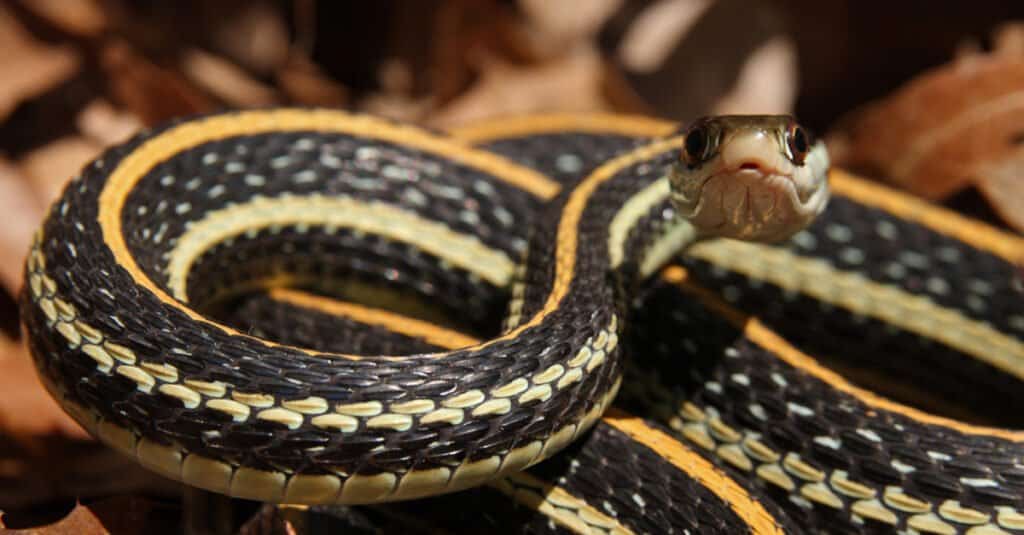
A single subspecies, the orange-striped ribbonsnake, also inhabits Tennessee.
©Ryan M. Bolton/Shutterstock.com
Western ribbonsnakes of the Tennessee River grow to between 20-30 inches long and have very long tails. Their bodies are characterized by alternating dark and light stripes that run from the base of the head to the tip of the tail. Their heads are light brown, with large, round eyes and shortened noses, and their undersides are pale yellow or green. These snakes eat primarily small toads, salamanders, frogs, tadpoles, and minnows.
8. Eastern Ribbonsnake

One subspecies, the common ribbon snake, lives in the southern and western parts of Tennessee.
©Steve Bower/Shutterstock.com
The eastern ribbonsnakes of the Tennessee River are slender snakes that grow between 18-26 inches long. They’re one of the lightest snakes on our list and have heads that are actually wider than their bodies. Alternating dark and light stripes run from their heads to their tails, with one thin light stripe down the center of their back. Their undersides are light yellow are green; juveniles look like miniature versions of adults. These snakes eat amphibians, fish, spiders, and insects.
9. Cottonmouth

Also known as water moccasins, these snakes only live in the western third of Tennessee.
©KF2017/Shutterstock.com
Cottonmouth snakes of the Tennessee River grow to between 30-42 inches long, with heavy bodies that resemble those of the rattlesnake. They range from dark brown with obscure markings to orange and brown with clear hexagonal bands. They get their name from the white interiors of their mouths, which they readily display in self-defense. These snakes are highly venomous members of the pit viper family. They eat amphibians, smaller snakes, rodents, birds, and lizards.
10. Smooth Earthsnake

The two subspecies of smooth earth snakes in Tennessee are the western and eastern smooth earth snakes.
©Matt Jeppson/Shutterstock.com
The smooth earth snakes of the Tennessee River grow to a maximum length of ten inches long. They have light brown bodies and narrow, slightly darker heads. These snakes spend much of their time underground, where they eat insects, insect larvae, slugs, snails, and earthworms. They’re also known as ground snakes and little brown snakes.
Summary of 10 Snakes of the Tennessee River
Here is a list of 10 snakes that can be found in or around the Tennessee River.
| Rank | Snake |
|---|---|
| 1 | Northern Water Snake |
| 2 | Southern Water Snake |
| 3 | Diamond-backed Water Snake |
| 4 | Plain-bellied Water Snake |
| 5 | Mississippi Green Water Snake |
| 6 | Common Gartersnake |
| 7 | Western Ribbonsnake |
| 8 | Eastern Ribbonsnake |
| 9 | Cottonmouth |
| 10 | Smooth Earthsnake |
The photo featured at the top of this post is © Seth LaGrange/Shutterstock.com
Discover the "Monster" Snake 5X Bigger than an Anaconda
Every day A-Z Animals sends out some of the most incredible facts in the world from our free newsletter. Want to discover the 10 most beautiful snakes in the world, a "snake island" where you're never more than 3 feet from danger, or a "monster" snake 5X larger than an anaconda? Then sign up right now and you'll start receiving our daily newsletter absolutely free.
Thank you for reading! Have some feedback for us? Contact the AZ Animals editorial team.







